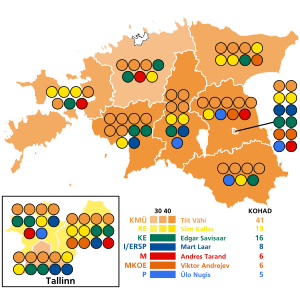
The history of Estonia forms a part of the history of Europe. Human settlement in what is now Estonia became possible 13,000–11,000 years ago, after the ice from the last glacial era had melted, and signs of the first permanent population in the region date from around 9000 BCE.

The Estonian Centre Party is a populist political party in Estonia. It was founded in 1991 as a direct successor of the Popular Front of Estonia, and it is currently led by Mihhail Kõlvart.

The Estonian Reform Party is a liberal political party in Estonia. The party has been led by Kristen Michal since 2024. It is colloquially known as the "Squirrel Party", referencing its logo.
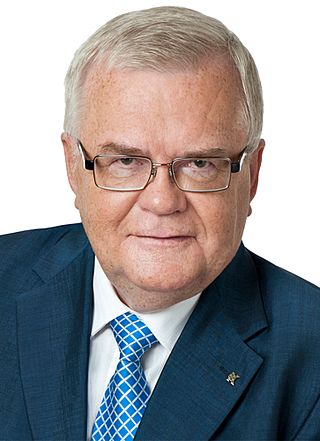
Edgar Savisaar was an Estonian politician, one of the founding members of Popular Front of Estonia and the Centre Party. He served as the acting Prime Minister of Estonia, Minister of the Interior, Minister of Economic Affairs and Communications, and twice mayor of Tallinn.
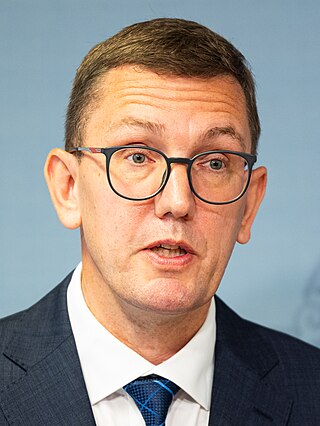
The prime minister of Estonia is the head of government of the Republic of Estonia. The prime minister is nominated by the president after appropriate consultations with the parliamentary factions and confirmed by the parliament (Riigikogu). In case of disagreement, the parliament can reject the president's nomination and choose their own candidate. In practice, since the prime minister must maintain the confidence of parliament in order to remain in office, they are usually the leader of the senior partner in the governing coalition. The current prime minister is Kristen Michal of the Reform Party. He took the office on 23 July 2024 following the resignation of Kaja Kallas.
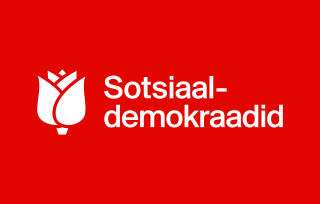
The Social Democratic Party is a centre-left political party in Estonia. It is currently led by Lauri Läänemets. The party was formerly known as the Moderate People's Party. The SDE has been a member of the Party of European Socialists since 16 May 2003 and was a member of the Socialist International from November 1990 to 2017. It is orientated towards the principles of social-democracy, and it supports Estonia's membership in the European Union. From April 2023, the party has been a junior coalition partner in the third Kallas government.
The Pro Patria Union was a national-conservative political party in Estonia. The party was founded on 2 December 1995 from a merger of the Estonian National Independence Party and the Pro Patria National Coalition.

Parliamentary elections were held in Poland on 25 September 2005. All 460 members of the Sejm and 100 senators of the Senate were elected. The election resulted in a sweeping victory for two opposition parties: the right-wing, national-conservative Law and Justice (PiS) and the centre-right, liberal-conservative Civic Platform (PO). The incumbent centre-left government of the Democratic Left Alliance (SLD) was soundly defeated. PiS won 155 seats and PO 133, while the governing SLD was reduced to fourth place with 55 seats, behind Andrzej Lepper's Self-Defence party, which won 56 seats.

Parliamentary elections were held in Estonia on 2 March 2003. The newly elected 101 members of the 10th Riigikogu assembled at Toompea Castle in Tallinn within ten days of the election. Two opposing parties won the most seats, with both the Centre Party and Res Publica Party winning 28 seats in the Riigikogu. Res Publica was able to gain enough support in negotiations after the elections to form a coalition government.

Parliamentary elections were held in Estonia on 7 March 1999. The newly elected 101 members of the 9th Riigikogu assembled at Toompea Castle in Tallinn within ten days of the election. The elections proved disastrous for the ruling Estonian Coalition Party, which won only seven seats together with two of its smaller allies. Following the elections, a coalition government was formed by Mart Laar of the Pro Patria Union, including the Reform Party and the Moderates. It remained in office until Laar resigned in December 2001, after the Reform Party had left the same governing coalition in Tallinn municipality, making opposition leader Edgar Savisaar new Mayor of Tallinn. The Reform Party and the Estonian Centre Party then formed a coalition government that lasted until the 2003 elections.
Parliamentary elections were held in Estonia alongside presidential elections on 20 September 1992, the first after regaining independence from the Soviet Union. The newly elected 101 members of the 7th Riigikogu assembled at Toompea Castle in Tallinn within ten days of the election. Following the elections, the five-party Fatherland Bloc led by Mart Laar formed a government together with national-conservative Estonian National Independence Party and centrist Moderates alliance. Voter turnout was 68%.

Parliamentary elections were held in Estonia on 4 March 2007. The newly elected 101 members of the 11th Riigikogu assembled at Toompea Castle in Tallinn within ten days of the election. It was the world's first nationwide vote where part of the voting was carried out in the form of remote electronic voting via the internet.

Isamaa is a Christian-democratic and national conservative political party in Estonia.

A parliamentary election was held in Estonia on 6 March 2011, with e-voting between 24 February and 2 March 2011. The newly elected 101 members of the 12th Riigikogu assembled at Toompea Castle in Tallinn within ten days of the election. The incumbent government of the Reform Party and IRL continued in office until 2014 when Prime Minister Andrus Ansip resigned, ending his tenure as the longest-serving Prime Minister in contemporary Estonian history. He was replaced by Taavi Rõivas who formed a new coalition government with SDE. The Riigikogu elected after this election was the least fragmented in Estonian history, featuring only four parties.
The Estonian Liberal Democratic Party, abbreviated to ELDP, was a social liberal political party in Estonia that existed between 1990 and 1994. The ELDP was founded on 9 March 1990, during the Estonian Soviet Socialist Republic, by the merger of the Liberal People's Party and the Free Democratic Party.
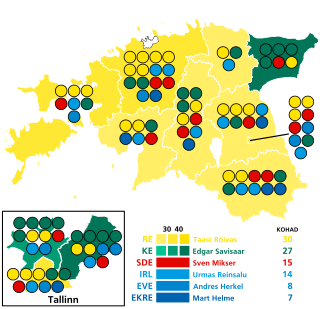
Parliamentary elections were held in Estonia on 1 March 2015. Advance voting was held between 19 and 25 February with a turnout of 33 percent. The Reform Party remained the largest in the Riigikogu, winning 30 of the 101 seats. Its leader, Taavi Rõivas, remained Prime Minister. The newly elected 101 members of the 13th Riigikogu assembled at Toompea Castle in Tallinn within ten days of the election. Two political newcomers, the Free Party and the Conservative People's Party (EKRE) crossed the threshold to enter the Riigikogu.
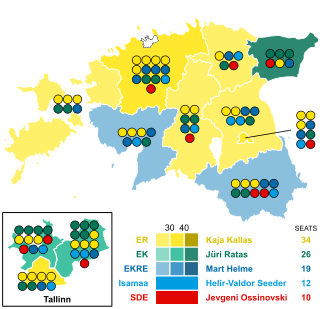
Parliamentary elections were held in Estonia on 3 March 2019. The newly elected 101 members of the 14th Riigikogu assembled at Toompea Castle in Tallinn within ten days of the election. The Reform Party remained the largest party, gaining four seats for a total of 34 and the Conservative People's Party had the largest gain overall, increasing their seat count by 12 to a total of 19 seats.
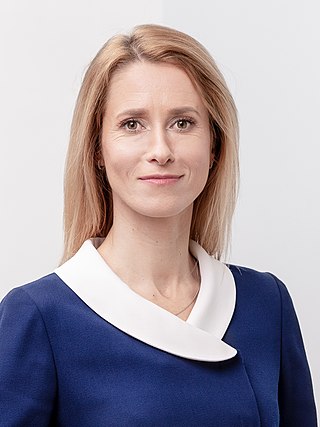
The second cabinet of Kaja Kallas, was the cabinet of Estonia from 18 July 2022 until 17 April 2023 when it was succeeded by the third Kallas cabinet following the 2023 election.

Triple Alliance is a commonly used political term in Estonia to refer to the various coalition governments between the centre-left Social Democratic Party, centre-right Reform Party and conservative Isamaa or their predecessors. This coalition has formed four times in history - from 1999 to 2002, from 2007 to 2009, from 2015 to 2016 and from 2022 to 2023. None of the coalitions governments have lasted a full parliamentary term. All of the Triple Alliance cabinets have been the second ones of the respective Prime Minister.

The Catholic Electoral Committee "Fatherland" was a conservative and Christian democratic electoral alliance in Poland. It consisted of five parties - the Christian National Union (ZChN), Conservative Party (PK), Christian-Peasant Party (SLCh), Party of Christian Democrats (PChD) and the Federation of Polish Entrepreneurship (FPP).
